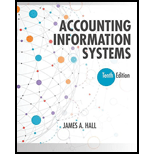
Accounting Information Systems
10th Edition
ISBN: 9781337619202
Author: Hall, James A.
Publisher: Cengage Learning,
expand_more
expand_more
format_list_bulleted
Question
Chapter 16, Problem 9MCQ
To determine
Identify the statement which is not a SDLC control issue during an audit.
Expert Solution & Answer
Trending nowThis is a popular solution!

Students have asked these similar questions
Can you solve this financial accounting problem with appropriate steps and explanations?
Please explain the solution to this financial accounting problem with accurate explanations.
Please provide the accurate answer to this general accounting problem using valid techniques.
Chapter 16 Solutions
Accounting Information Systems
Ch. 16 - Prob. 1RQCh. 16 - Prob. 2RQCh. 16 - Prob. 3RQCh. 16 - Prob. 4RQCh. 16 - Prob. 5RQCh. 16 - Prob. 6RQCh. 16 - Prob. 7RQCh. 16 - What is the importance of the SPL?Ch. 16 - Prob. 9RQCh. 16 - Prob. 10RQ
Ch. 16 - Prob. 11RQCh. 16 - Prob. 12RQCh. 16 - What tests may be conducted for identifying...Ch. 16 - Prob. 14RQCh. 16 - Prob. 15RQCh. 16 - Prob. 16RQCh. 16 - Prob. 17RQCh. 16 - Prob. 18RQCh. 16 - Prob. 19RQCh. 16 - Prob. 20RQCh. 16 - Prob. 1DQCh. 16 - Prob. 2DQCh. 16 - Prob. 3DQCh. 16 - What are rounding error routines, and why are they...Ch. 16 - Prob. 5DQCh. 16 - Prob. 6DQCh. 16 - Prob. 7DQCh. 16 - Prob. 8DQCh. 16 - The systems development life cycle is a...Ch. 16 - Prob. 10DQCh. 16 - Prob. 11DQCh. 16 - Compare and contrast the following techniques...Ch. 16 - Prob. 13DQCh. 16 - Prob. 1MCQCh. 16 - Prob. 2MCQCh. 16 - Which of the following is NOT an SDLC controllable...Ch. 16 - Prob. 4MCQCh. 16 - Which of the following statements is NOT correct?...Ch. 16 - Prob. 6MCQCh. 16 - Prob. 7MCQCh. 16 - Prob. 8MCQCh. 16 - Prob. 9MCQCh. 16 - Prob. 10MCQCh. 16 - Prob. 1PCh. 16 - Prob. 2PCh. 16 - Prob. 3PCh. 16 - Prob. 4PCh. 16 - Prob. 5PCh. 16 - Prob. 6PCh. 16 - Prob. 7PCh. 16 - Prob. 8PCh. 16 - Prob. 9PCh. 16 - The Balcar Companys external auditors are...Ch. 16 - Prob. 11PCh. 16 - Prob. 12PCh. 16 - Prob. 13PCh. 16 - Prob. 14PCh. 16 - Prob. 15PCh. 16 - Prob. 16PCh. 16 - Prob. 17PCh. 16 - Prob. 18P
Knowledge Booster
Similar questions
- At the end of last year, Penélope, a 30% partner in the three-person JPM partnership, had an outside basis of $45,000, which included her $15,000 share of JPM's debt. On February 15 of the current year, Penélope sells her partnership interest to Thomas for a cash payment of $35,000 and the assumption of her share of JPM's debt. JPM has no hot assets. What is the amount and character of Penélope's recognized gain or loss on the sale? A. $4,000 capital loss B. $4,000 ordinary loss C. $5,000 capital gain D. $8,000 ordinary incomearrow_forwardI need help with this general accounting problem using proper accounting guidelines.arrow_forwardWhat was the net income for the period?arrow_forward
- I am trying to find the accurate solution to this general accounting problem with the correct explanation.arrow_forwardWhat is company net income?arrow_forwardInnovative Training Solutions is a business coaching firm. At the end of its accounting period, December 31, 2022, Innovative had assets of $720,000 and liabilities of $230,000. Determine the net income (or loss) during 2023, assuming that as of December 31, 2023, assets were $910,000, liabilities were $160,000, and no additional capital stock was issued or dividends paid. Provide answerarrow_forward
arrow_back_ios
SEE MORE QUESTIONS
arrow_forward_ios
Recommended textbooks for you
 Accounting Information SystemsAccountingISBN:9781337619202Author:Hall, James A.Publisher:Cengage Learning,
Accounting Information SystemsAccountingISBN:9781337619202Author:Hall, James A.Publisher:Cengage Learning, Auditing: A Risk Based-Approach to Conducting a Q...AccountingISBN:9781305080577Author:Karla M Johnstone, Audrey A. Gramling, Larry E. RittenbergPublisher:South-Western College Pub
Auditing: A Risk Based-Approach to Conducting a Q...AccountingISBN:9781305080577Author:Karla M Johnstone, Audrey A. Gramling, Larry E. RittenbergPublisher:South-Western College Pub Auditing: A Risk Based-Approach (MindTap Course L...AccountingISBN:9781337619455Author:Karla M Johnstone, Audrey A. Gramling, Larry E. RittenbergPublisher:Cengage Learning
Auditing: A Risk Based-Approach (MindTap Course L...AccountingISBN:9781337619455Author:Karla M Johnstone, Audrey A. Gramling, Larry E. RittenbergPublisher:Cengage Learning

Accounting Information Systems
Accounting
ISBN:9781337619202
Author:Hall, James A.
Publisher:Cengage Learning,

Auditing: A Risk Based-Approach to Conducting a Q...
Accounting
ISBN:9781305080577
Author:Karla M Johnstone, Audrey A. Gramling, Larry E. Rittenberg
Publisher:South-Western College Pub

Auditing: A Risk Based-Approach (MindTap Course L...
Accounting
ISBN:9781337619455
Author:Karla M Johnstone, Audrey A. Gramling, Larry E. Rittenberg
Publisher:Cengage Learning